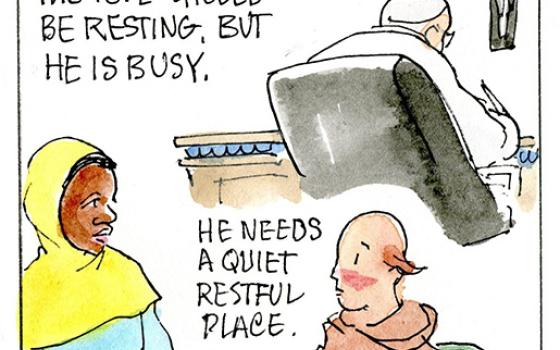THE NEW DEAL: A MODERN HISTORY
By Michael Hiltzik
Published by Free Press, $30
There is no question that we Americans find ourselves in the midst of a pressing economic crisis. High unemployment, a tsunami of home foreclosures, massive teacher layoffs, and a myriad of other problems tear at our social fabric. What does seem up for debate is the appropriate response to this crisis. How aggressive should the federal government be in trying to resolve these problems? That we cannot agree on the proper way forward makes Michael Hiltzik’s The New Deal: A Modern History timely and instructive. He suggests implicitly that today’s federal response is pretty tepid in comparison to the bold federal efforts that Franklin Delano Roosevelt led in the 1930s. Hiltzik reminds readers that Depression-era Americans established for the first time that their government “should serve the people, all the people, and that none should be forgotten.”
Hiltzik calls his book “A Modern History,” which means that he wrote in light of our 21st-century economic collapse. The parallels to today’s situation ring powerfully in this narrative. Both eras feature banking failures at their outsets, public works packages to jump- start economic activity, the creation or expansion of social safety nets (social security and bank deposit insurance in the 1930s, a version of universal health care today), and well-funded opposition orchestrated by economic elites (major newspaper chains and the Liberty League in the 1930s, FOX News and the tea party today).
Key distinctions also stand out, and have shaped our response to the modern crisis. Some of the strongest advocates of liberal reform in the 1930s came from the progressive wing of the opposition Republican Party -- a political entity with no such modern appendage. Today’s Republican Party stands in unified, abject opposition to any federal strategies to resolve the crisis. In fact, Republican leaders argue today that the federal government caused the current crisis.
The New Deal came after four years of economic dislocation had rendered Americans desperate for remedies. FDR had more latitude to attempt ambitious programs than Barack Obama had at the outset of his presidency, only months removed from the housing market collapse of 2008. That 21st-century bank failures did not vitiate people’s savings in today’s crisis was because the New Deal created federal deposit insurance specifically to protect those accounts.
The contemporary corporate abandonment of pension obligations did not push retirees into absolute poverty because another New Deal program, Social Security, offers them a modest income.
Hiltzik’s work also raises some powerful and perhaps unexpected parallels. Obama’s character predilections bear a striking resemblance to those of Herbert Hoover. Both seemed more at ease with incremental adjustments than bold experiments. Just as Obama has, so Hoover relied on an elite core of economic insiders to devise plans to stabilize the banks so that they would, of their own accord, lend money to spur the economy. Like Obama, Hoover sought to establish a fund for massive public works initiatives designed to provide employment -- the Hoover Dam was the most prominent of these. And Hoover’s team of economic advisors actually designed the bank reform package that FDR implemented.
It was Hoover’s willingness to intervene that in fact has drawn the enmity of many conservative revisionist historians. They blame both Hoover and Roosevelt for exacerbating and prolonging the Great Depression. According to these historians, both presidents’ interference in the “free markets” at least delayed recovery and perhaps caused the Depression to earn its appellation of “Great” in the first place. Hiltzik dismisses these interpretations as “ideological polemics” devoid of evidentiary support. His Hoover was a bright, inquisitive, intellectually nimble civic engineer who was ultimately too timid to undertake the dramatic federal action needed to boost the nation out of the Great Depression.
 Hiltzik’s Franklin Roosevelt is also much like Obama, and vice versa. Obama has an uncanny ability to frame issues clearly and persuasively for the broader population in his formal public addresses on key issues. Like Roosevelt, who relied on the radio, Obama uses a “new” media (the Internet, Twitter, texts) effectively to bypass the guardians of public discourse to address citizens directly. And just as FDR’s ill-timed worries about budget deficits led to dramatic cuts in federal spending and the “Roosevelt recession” of 1937, so too Obama’s worries about the accumulating public debt moved him to agree too readily to Republican calls for budget restraints and even cuts that blunt our recovery today.
Hiltzik’s Franklin Roosevelt is also much like Obama, and vice versa. Obama has an uncanny ability to frame issues clearly and persuasively for the broader population in his formal public addresses on key issues. Like Roosevelt, who relied on the radio, Obama uses a “new” media (the Internet, Twitter, texts) effectively to bypass the guardians of public discourse to address citizens directly. And just as FDR’s ill-timed worries about budget deficits led to dramatic cuts in federal spending and the “Roosevelt recession” of 1937, so too Obama’s worries about the accumulating public debt moved him to agree too readily to Republican calls for budget restraints and even cuts that blunt our recovery today.
Finally, Obama’s recent call for job creation through federal infrastructure spending and his newfound willingness to champion a more robustly Keynesian approach to ending the recession resemble FDR’s stalwart support for a vigorous federal response to conditions that threaten the welfare of American citizens.
In Hiltzik’s previous book, Colossus: Hoover Dam and the Making of the American Century, he argued that New Deal programs “transformed [America] from a society that glorified individualism into one that cherished shared enterprise and communal social support.”
That fundamental value is at stake in today’s debates.
Hiltzik reminds us that, just as we chose in the 1930s to steer toward mutual social and economic responsibility through the New Deal, our choices today will create, sustain, or transform the society our children will inhabit for decades to come. The lessons he shares from our not-too-distant past point us to renew our commitment to shared enterprise, to public policies aimed to lift all Americans to lives of dignity, security, and social consciousness -- to serve all people, forgetting no one.
[Timothy Kelly is department chair and professor of history at St. Vincent College, Latrobe, Pa.]




